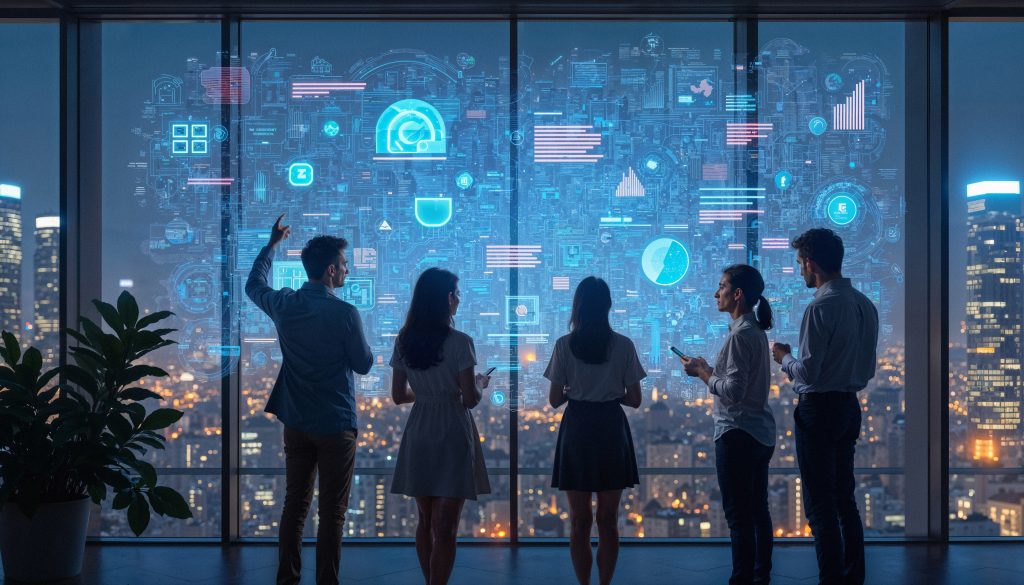The way we work has always evolved alongside technology, but in 2025 the pace of change is faster than ever. Artificial intelligence, automation, virtual collaboration, and digital-first business models are transforming work at every level. From how employees perform daily tasks to how organizations manage global teams, how digital innovations are shaping the future of work is one of the most critical conversations for leaders, policymakers, and workers alike.
This transformation is not only about tools but also about culture, productivity, and the fundamental expectations of work itself. According to McKinsey’s 2024 Future of Work report, nearly 60% of current occupations now include tasks that could be automated by digital technologies, while Gartner notes that 80% of enterprises have adopted hybrid or fully digital workflows. These changes highlight both opportunities and challenges for businesses navigating a new digital-first landscape.

Why Digital Innovations Matter for the Future of Work
The modern workforce is no longer confined to office buildings or nine-to-five schedules. Employees expect flexibility, organizations need resilience, and customers demand faster, more personalized services. Digital innovations bridge these needs by enabling smarter collaboration, improving decision-making, and boosting efficiency.
At the same time, they present challenges such as data security, workforce displacement, and the need for continuous reskilling. Companies that succeed in the digital workplace will be those that balance technology adoption with human-centered strategies.
Key Digital Innovations Reshaping Work
1. Artificial Intelligence and Automation
AI is at the center of digital workplace transformation. From automating repetitive tasks to enabling predictive insights, AI is streamlining workflows and freeing employees to focus on higher-value activities.
Practical examples include:
- AI-powered chatbots handling routine customer service inquiries.
- Predictive analytics forecasting market trends and consumer behavior.
- Natural language processing tools summarizing meeting notes or generating reports.
According to PwC, AI could contribute 15.7 trillion to the global economy by 2030, with much of the value stemming from productivity improvements. For workers, AI is not just about replacement—it is increasingly about augmentation, giving people smarter tools to make decisions and innovate.
2. Virtual Collaboration and Asynchronous Work
The pandemic accelerated adoption of remote collaboration tools, but in 2025 these tools have matured into more advanced ecosystems. Platforms like Zoom, Microsoft Teams, and Slack are now integrating AI features such as automated transcription, real-time translation, and smart meeting summaries.
Asynchronous work practices are also gaining traction. Teams distributed across time zones rely less on constant meetings and more on shared documents, recorded updates, and digital whiteboards. This approach reduces meeting overload while giving employees more control over their schedules.
Why it matters: Digital innovations in collaboration are not just improving convenience—they are making global teamwork seamless and sustainable.
3. Cloud and Edge Computing
Cloud computing has already revolutionized data storage and access, but the rise of edge computing is further changing how organizations handle information. Edge technologies allow data to be processed closer to where it is generated, reducing latency and improving speed.
For industries like healthcare, logistics, and manufacturing, this means real-time decision-making at scale. A warehouse, for example, can use IoT sensors and edge computing to track inventory instantly and adjust operations without waiting for centralized systems.
Why it matters: Cloud and edge technologies give organizations the agility and resilience required in a fast-moving digital economy.
4. Digital Employee Experience Platforms
Employee engagement has become a top priority for organizations navigating hybrid and remote work. Digital employee experience (DEX) platforms integrate HR, IT, and collaboration tools to provide seamless interactions across devices and locations.
These platforms often include:
- Personalized dashboards for tasks, learning, and company news.
- AI-driven career development recommendations.
- Automated IT support for common issues.
Forrester research shows that companies investing in DEX see a 20% improvement in employee satisfaction and retention. In 2025, providing a strong digital workplace experience is no longer optional—it is a core part of attracting and retaining talent.
5. Cybersecurity and Zero-Trust Models
With greater digital adoption comes increased risk. As more employees work remotely and data flows across multiple platforms, cybersecurity has become a cornerstone of future work strategies.
Zero-trust security models, which assume no user or device is inherently trustworthy, are gaining traction. Combined with AI-driven threat detection, these models continuously verify identity and monitor behavior to prevent breaches.
According to IBM’s 2024 Cost of a Data Breach report, companies using AI-enhanced security reduced breach lifecycles by an average of 108 days, saving millions in potential damages.
Why it matters: Without secure systems, digital innovation cannot scale effectively or sustainably.
6. Upskilling Through Digital Learning Platforms
The shift toward digital work has created a parallel demand for continuous learning. Traditional training programs are being replaced by adaptive, AI-powered learning platforms that provide personalized pathways.
Examples include Coursera, LinkedIn Learning, and Udemy Business, which now integrate AI to recommend courses based on skills gaps and career goals. Microlearning formats, gamification, and VR-based training environments are also making education more engaging and effective.
Why it matters: As automation reshapes jobs, reskilling and upskilling through digital platforms are essential to workforce resilience.
7. Immersive Technologies: AR and VR
Augmented reality (AR) and virtual reality (VR) are moving beyond gaming into mainstream work applications. Remote onboarding, design collaboration, and immersive training programs are all leveraging AR and VR to create more engaging experiences.
For instance, architects use AR to visualize building plans in real-world environments, while global teams collaborate in VR meeting rooms that mimic in-person interactions.
Gartner predicts that by 2030, 25% of the workforce will spend at least an hour daily in the metaverse for work, learning, or collaboration.
Why it matters: Immersive technologies create deeper engagement, reduce travel needs, and improve knowledge retention.
Practical Strategies for Organizations Embracing Digital Innovations
Adopting digital technologies requires more than purchasing new tools. To maximize impact, organizations should consider these practical strategies:
- Invest in AI where it adds value—automate repetitive processes but ensure human oversight remains central.
- Adopt asynchronous collaboration practices to reduce meeting overload and support global teams.
- Prioritize cybersecurity and zero-trust systems to protect digital assets.
- Create continuous learning pathways through digital platforms to reskill employees at scale.
- Focus on employee experience by integrating digital tools that improve engagement and productivity.
- Experiment with immersive technologies for training, onboarding, and design to build future-ready skills.
- Balance technology with culture—ensure that digital adoption strengthens, rather than replaces, human connection.
Challenges Ahead
While digital innovations bring clear benefits, they also pose challenges that organizations must navigate carefully:
- Digital divide: Not all workers have equal access to digital tools or stable connectivity.
- Change resistance: Employees may resist adopting new systems without proper training and communication.
- Work-life balance: The same tools that enable flexibility can also blur boundaries, leading to burnout.
- Ethics and trust: AI-driven decisions in hiring, performance management, or security raise concerns about fairness and privacy.
Addressing these challenges requires strong leadership, transparent communication, and a focus on inclusive, human-centered digital strategies.
The Future of Work in a Digital Age
The future of work is not about replacing humans with machines but about creating systems where humans and digital innovations complement each other. AI will handle data-heavy tasks, immersive technologies will make learning more engaging, and digital platforms will connect employees across the globe.
At the same time, employees will increasingly demand flexibility, meaningful work, and opportunities for growth. Organizations that embrace both technological innovation and human-centered leadership will define the workplaces of tomorrow.
In 2025, digital innovations are no longer optional—they are shaping competitive advantage, employee satisfaction, and long-term resilience. The challenge is not whether to adopt them but how to adopt them responsibly and effectively.
Conclusion
How digital innovations are shaping the future of work is one of the defining questions of our time. From AI and automation to immersive technologies and cybersecurity, these innovations are transforming work into a more flexible, data-driven, and connected experience.
Organizations that invest in smart, secure, and inclusive digital practices will not only adapt to change but thrive in it. The future of work belongs to those who see digital transformation not as a disruption to survive but as an opportunity to reimagine what work can be.
References
- The future of work: an overview from McKinsey Report, https://nestorup.com
- Superagency in the workplace: https://www.mckinsey.com
- Microsoft Teams thinks it might have solved your collaboration, https://www.techradar.com









